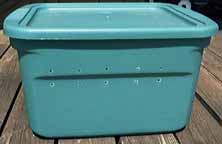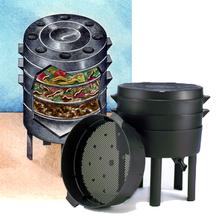Redworms (commonly called red wigglers) and brown-nose worms can be used to compost food scraps. The worms live in paper or cardboard bedding into which kitchen scraps are placed. They eat both the bedding and the kitchen scraps and excrete worm castings.
Worm castings are often referred to as "black gold" because they make an excellent organic fertilizer.
Worm bins do not smell because the worms eat the rotting or smelly portion of the food in their bin. As long as the bins are not overfed, there is no rotting food left to make an odor.
1. Either buy or build a wood or plastic container. When choosing a home for your worms, remember that worms hate light and require a temperature between 40 and 80 degrees Fahrenheit to survive. The bin will need aeration so the worms can breath. Plan on one square foot of surface for each pound of garbage per week. A 10-gallon plastic tub with a lid that snaps shut would be a good choice. Punch 1/8 inch holes about 1 inch apart around the sides of the bin to provide air for the worms.
There are numerous vendors of vermicomposting systems, such as the Can-O-Worms™ system shown below. The best option would be to recycle something like an old dresser drawer, trunk, or discarded barrel.


2. Add bedding to the worm bin until the bin is 1/3 full. Suitable bedding materials include shredded newspaper and cardboard, shredded fall leaves, dead plants, sawdust, peat moss, compost, and aged manure. If convenient, vary the bedding in the bin as much as possible to provide more nutrients for the worms, thus creating richer compost. Moisten the dry bedding materials before putting them in the bin, so that the overall moisture level is like a wrung-out sponge.
3. Add a couple of handfuls of sand or soil to provide necessary grit for the worm's digestion of food.
4. Add approximately a pound of worms for each pound of food scraps you plan to compost each week. The two types of earthworms best suited to worm composting are redworms: Eisenia foetida (commonly known as red wiggler, branding, or manure worm) and Lumbricus rubellus (also called the dung worm).
Consider purchasing your worms regionally. One local vendor is listed below.
Grand Prairie's Worm Farm
1005 SW 2nd Street
Grand Prairie, TX 75051
(972) 642-0979
The following vendor is located outside the North Texas region, but can ship worms year round.
Hall's Wormery
660 Lake Dam Road
Blackwell, TX 79506
(325) 743-2355
www.hallswormery.com